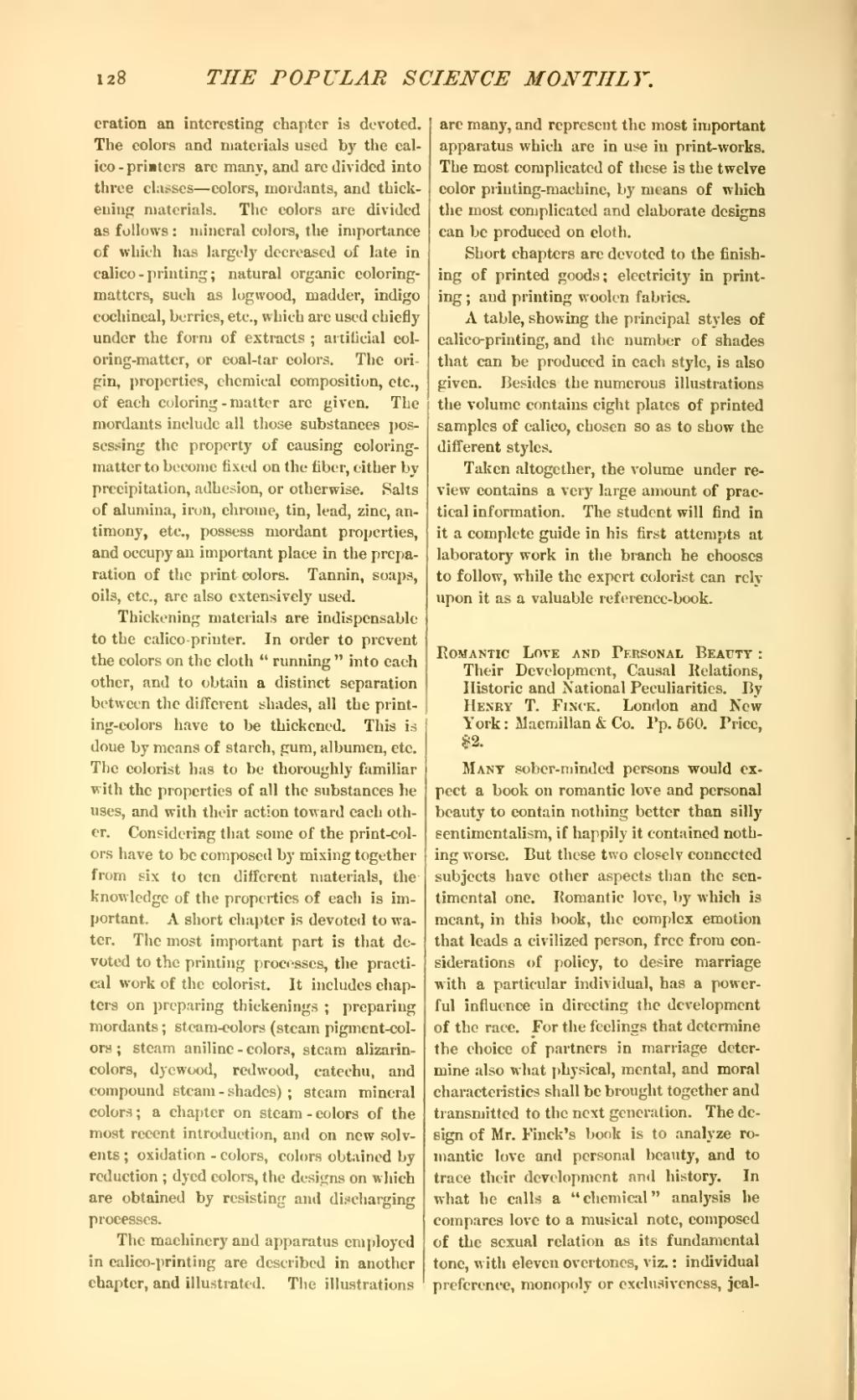eration an interesting chapter is devoted. The colors and materials used by the calico-printers are many, and are divided into three classes—colors, mordants, and thickening materials. The colors are divided as follows: mineral colors, the importance of which has largely decreased of late in calico-printing; natural organic coloring matters, such as logwood, madder, indigo cochineal, berries, etc., which are used chiefly under the form of extracts; artificial coloring-matter, or coal-tar colors. The origin, properties, chemical composition, etc., of each coloring-matter arc given. The mordants include all those substances possessing the property of causing coloring matter to become fixed on the fiber, either by precipitation, adhesion, or otherwise. Salts of alumina, iron, chrome, tin, lead, zinc, antimony, etc., possess mordant properties, and occupy an important place in the preparation of the print-colors. Tannin, soaps, oils, etc., are also extensively used.
Thickening materials are indispensable to the calico-printer. In order to prevent the colors on the cloth "running" into each other, and to obtain a distinct separation between the different shades, all the printing-colors have to be thickened. This is done by means of starch, gum, albumen, etc. The colorist has to be thoroughly familiar with the properties of all the substances he uses, and with their action toward each other. Considering that some of the print-colors have to be composed by mixing together from six to ten different materials, the knowledge of the properties of each is important. A short chapter is devoted to water. The most important part is that devoted to the printing processes, the practical work of the colorist. It includes chapters on preparing thickenings; preparing mordants; steam-colors (steam pigment-colors; steam aniline-colors, steam alizarin colors, dyewood, redwood, catechu, and compound steam-shades); steam mineral colors; a chapter on steam-colors of the most recent introduction, and on new solvents; oxidation-colors, colors obtained by reduction; dyed colors, the designs on which are obtained by resisting and discharging processes.
The machinery and apparatus employed in calico-printing are described in another chapter, and illustrated. The illustrations are many, and represent the most important apparatus which are in use in print-works. The most complicated of these is the twelve color printing-machine, by means of which the most complicated and elaborate designs can be produced on cloth.
Short chapters are devoted to the finishing of printed goods; electricity in printing; and printing woolen fabrics.
A table, showing the principal styles of calico-printing, and the number of shades that can be produced in each style, is also given. Besides the numerous illustrations the volume contains eight plates of printed samples of calico, chosen so as to show the different styles.
Taken altogether, the volume under review contains a very large amount of practical information. The student will find in it a complete guide in his first attempts at laboratory work in the branch he chooses to follow, while the expert colorist can rely upon it as a valuable reference-book.
Romantic Love and Personal Beauty: Their Development, Causal Relations, Historic and National Peculiarities. By Henry T. Finck. London and New York: Macmillan & Co. Pp. 560. Price, $2.
Many sober-minded persons would expect a book on romantic love and personal beauty to contain nothing better than silly sentimentalism, if happily it contained nothing worse. But these two closely connected subjects have other aspects than the sentimental one. Romantic love, by which is meant, in this book, the complex emotion that leads a civilized person, free from considerations of policy, to desire marriage with a particular individual, has a powerful influence in directing the development of the race. For the feelings that determine the choice of partners in marriage determine also what physical, mental, and moral characteristics shall be brought together and transmitted to the next generation. The design of Mr. Finck's book is to analyze romantic love and personal beauty, and to trace their development and history. In what he calls a "chemical" analysis he compares love to a musical note, composed of the sexual relation as its fundamental tone, with eleven overtones, viz.: individual preference, monopoly or exclusiveness, jeal-
